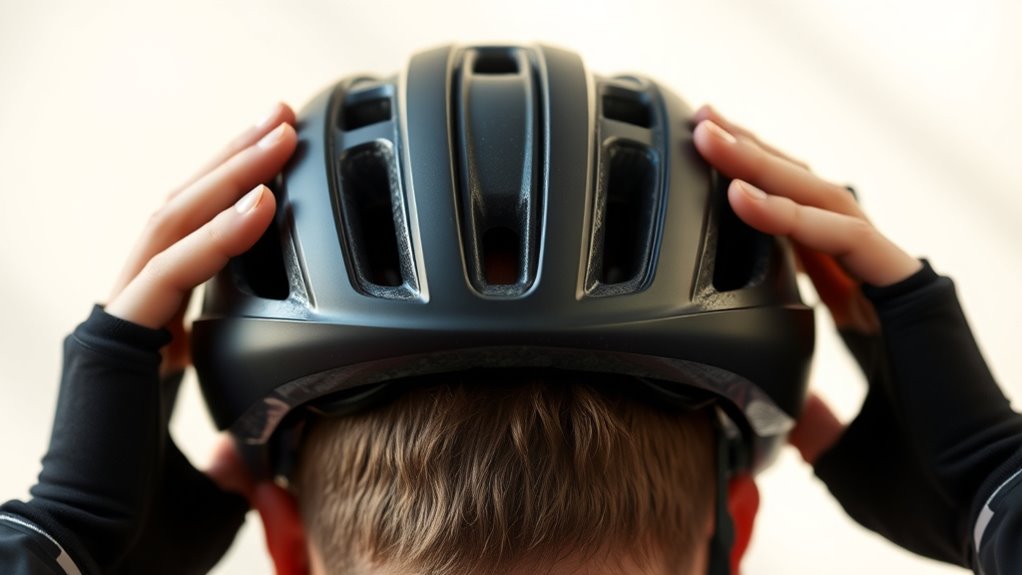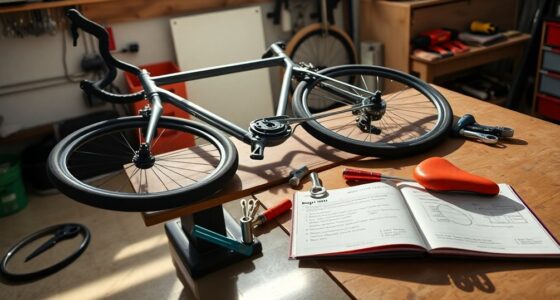To properly fit and wear a bike helmet, start by measuring your head about an inch above your eyebrows and choose a helmet that matches that size. Place the helmet level, snug but comfortable, and sit low on your forehead. Adjust the straps into a “V” shape just below your earlobes, tightening until only one or two fingers fit beneath. Ensuring a secure, level fit helps protect you better—keep exploring these steps for maximum safety.
Key Takeaways
- Measure your head circumference about one inch above eyebrows and select a helmet that fits snugly and securely.
- Place the helmet level and centered, sitting low on the forehead, about one to two finger-widths above eyebrows.
- Adjust the straps into a “V” shape under the ears, ensuring they are snug but comfortable under the chin.
- Perform a fit stability test by gently shaking your head, ensuring the helmet moves slightly but doesn’t shift or slide excessively.
- Regularly check and maintain the fit, ensuring the helmet remains level and properly positioned before each ride.

Wearing a properly fitted bike helmet is essential for your safety on the road or trail. When you hop on your bike, your helmet should feel comfortable, secure, and snug enough to stay in place during a fall or sudden stop. To achieve this, start by selecting a helmet that fits your head size. Use a measuring tape to determine the circumference around your head, about one inch above your eyebrows. Most helmets come with adjustable sizing systems, so choose one that corresponds closely to your measurement for a better fit.
Once you have the right helmet, place it on your head level and centered. The helmet should sit low on your forehead, about one to two finger-widths above your eyebrows, to protect your forehead effectively. Avoid tilting it back or forward; it should sit flat and evenly on your head. The straps are equally important. Pull the side straps down and adjust them so they form a “V” shape under your ears, with the bottom of the “V” sitting right below your earlobes. When you tighten the straps, the helmet should feel snug but not painful. You want it to stay in place without causing discomfort or pressure points.
Next, perform the stability test to ensure a proper fit. Gently shake your head from side to side and up and down. The helmet should move slightly but not shift around excessively. If it slides or feels loose, tighten the straps further. Conversely, if it causes discomfort or leaves marks on your skin, loosen the straps slightly. Once the helmet feels secure, check the front and back alignment. It should sit level and not tilt forward or backward, providing maximum protection. Incorporating Advanced fitting techniques can further optimize helmet safety and comfort, especially for unique head shapes. Additionally, ensuring that your helmet complies with safety standards adds an extra layer of assurance for your protection.
Remember that proper helmet fit is critical to ensure maximum protection, so take the time to adjust all straps and the helmet position carefully. Lastly, make sure the straps are buckled correctly and snug against your chin. You should be able to fit only one or two fingers between your chin and the strap. When you open your mouth wide, you should feel the helmet press down slightly on your head and straps tighten. This indicates a secure fit that won’t shift during riding. Regularly check your helmet’s fit before every ride, especially if you’re using it for multiple sessions or after any impacts. A well-fitted helmet might seem like a small detail, but it can be the difference between safe riding and a serious injury. Prioritizing proper fit ensures maximum protection and peace of mind every time you hit the road or trail.
Frequently Asked Questions
How Often Should I Replace My Bike Helmet?
You should replace your bike helmet every 5 to 10 years, even if it hasn’t been in a crash. Over time, the materials can degrade, reducing its protective ability. If you experience a significant impact or notice cracks, dents, or frayed straps, replace it immediately. Regularly inspecting your helmet guarantees you’re protected properly, and replacing it when needed keeps you safe during every ride.
Can I Wear a Helmet While Listening to Music?
Many believe wearing headphones while biking is safe, but studies show it can be risky. Listening to music can distract you from traffic sounds and emergency signals. To stay alert and protect yourself, it’s best to avoid wearing headphones or keep volume low. Your safety depends on hearing your surroundings, so prioritize situational awareness over music. Stay focused and attentive to ensure a safe ride.
Are Helmet Vents Sufficient for Hot Weather?
Helmet vents are generally adequate for hot weather, helping to keep your head cool by allowing airflow. Make certain your helmet has enough vents for proper ventilation, and adjust the fit so it stays secure without being too tight. If you’re still feeling hot, consider wearing moisture-wicking headbands or taking breaks to cool down. Proper ventilation ensures comfort and safety during summer rides.
What if My Helmet Feels Uncomfortable or Tight?
Imagine your helmet as a snug, supportive hug—if it feels uncomfortable or tight, it might be too constricting. You should be able to breathe easily and move your head without feeling squished. Check the fit by adjusting the straps and padding; a well-fitted helmet should sit level and firm without pressing too hard. If discomfort persists, consider trying a different size or style for a better, more comfortable fit.
Do Different Helmet Styles Offer Different Levels of Protection?
Different helmet styles do offer varying levels of protection. For example, full-face helmets provide more coverage for your face and jaw, ideal for downhill biking or motocross. Mountain bike helmets often have extended rear coverage, while road helmets focus on aerodynamics and ventilation. Choose a style suited to your riding type, and make certain it meets safety standards, so you get the best protection where you need it most.
Conclusion
So, there you have it—your ultimate guide to foolproof helmet fitting. Remember, a helmet that sits crooked or feels like a medieval torture device isn’t exactly your ticket to safety or style. Take a minute to tighten, adjust, and smile confidently—because nothing says “I care” like showing up for your ride with a helmet that actually works. After all, a proper fit isn’t just for looks; it’s your best shot at avoiding an unplanned crash course in humility.









